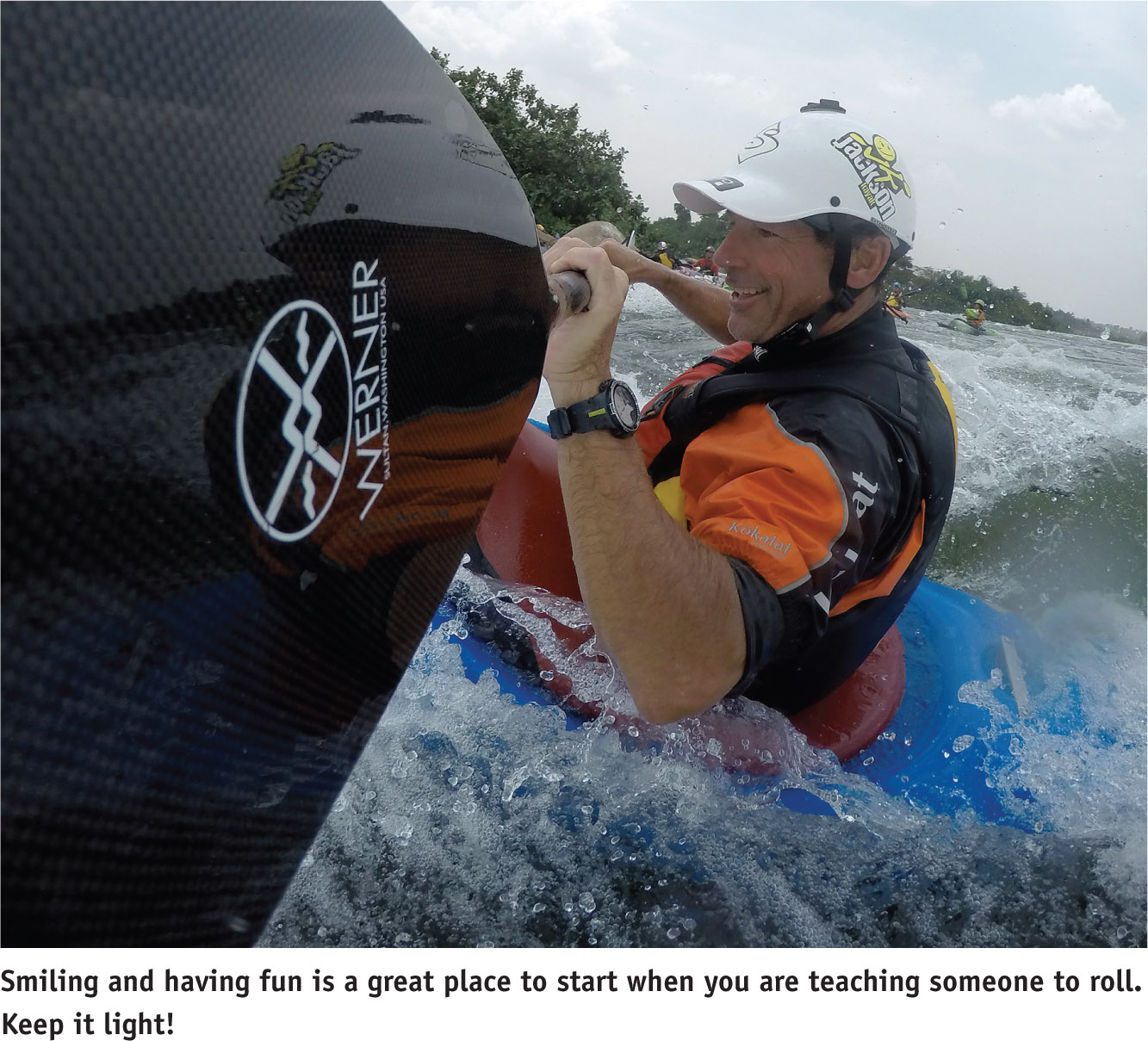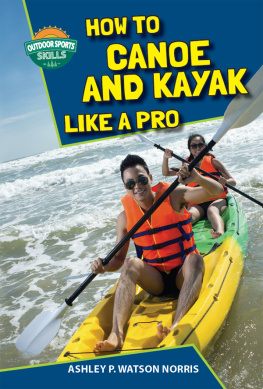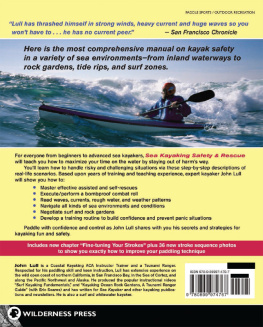Eric Jackson - Kayaking with Eric Jackson: Rolling and Bracing
Here you can read online Eric Jackson - Kayaking with Eric Jackson: Rolling and Bracing full text of the book (entire story) in english for free. Download pdf and epub, get meaning, cover and reviews about this ebook. year: 2016, publisher: Stackpole Books, genre: Romance novel. Description of the work, (preface) as well as reviews are available. Best literature library LitArk.com created for fans of good reading and offers a wide selection of genres:
Romance novel
Science fiction
Adventure
Detective
Science
History
Home and family
Prose
Art
Politics
Computer
Non-fiction
Religion
Business
Children
Humor
Choose a favorite category and find really read worthwhile books. Enjoy immersion in the world of imagination, feel the emotions of the characters or learn something new for yourself, make an fascinating discovery.

- Book:Kayaking with Eric Jackson: Rolling and Bracing
- Author:
- Publisher:Stackpole Books
- Genre:
- Year:2016
- Rating:5 / 5
- Favourites:Add to favourites
- Your mark:
- 100
- 1
- 2
- 3
- 4
- 5
Kayaking with Eric Jackson: Rolling and Bracing: summary, description and annotation
We offer to read an annotation, description, summary or preface (depends on what the author of the book "Kayaking with Eric Jackson: Rolling and Bracing" wrote himself). If you haven't found the necessary information about the book — write in the comments, we will try to find it.
Kayaking with Eric Jackson: Rolling and Bracing — read online for free the complete book (whole text) full work
Below is the text of the book, divided by pages. System saving the place of the last page read, allows you to conveniently read the book "Kayaking with Eric Jackson: Rolling and Bracing" online for free, without having to search again every time where you left off. Put a bookmark, and you can go to the page where you finished reading at any time.
Font size:
Interval:
Bookmark:
CHAPTER 6
M y winning strategy for teaching others to roll is to run my student through a series of successes, keeping failures to a minimum, and getting the student to her first roll very quickly.

What is the reason for this strategy? Those who decide to try whitewater kayaking are entering into the unknown. Most of the time, students are trying it, hoping theyll like it and hoping the skills will come easily. Usually, the student learning to roll doesnt have a lot invested into the sport yet and isnt fully committed to being a kayaker. This lack of commitment, coupled with the typical instruction programs that, more often than not, dont have a winning strategy for teaching whitewater kayaking (the roll being a big component of that), is why only 10 percent of the students who take a beginner kayak class become self-sufficient kayakers. The other 90 percent dont have an experience rewarding enough for them to commit to overcoming the obstacles of learning the sport, so they just never come back. These people will tell you they tried kayaking before and liked it, but they dont own a boat and dont go whitewater kayaking.
If you are teaching students to roll, be sure your student is being set up mentally to become a kayaker and that the experience you put her through is for her benefit, not yours. Of the 90 percent of students who try kayaking but dont become kayakers, my estimate is that at least 50 percent of them would have loved becoming kayakers and would have become one if their experiences had been more rewarding and meaningful and if they had more reasons to keep going.
Here is the strategy I believe is the most effective for teaching beginner kayaking, in general, but it also applies specifically to teaching the roll.
First, think about every step students go through, including the dialogue they are part of throughout the lesson. The experiences they have with each step and the dialogue can be broken into three categories: positive, neutral, or negative. Students come to you and to the learning experience with different amounts of mental equity or bank account balances related to becoming a whitewater kayaker. Some students have waited their entire lives and cant imagine anything they would rather do than learn to kayak and become a kayaker. Most want to try it, think it would be fun, want to see for themselves, and hope it is for them. A few are terrified but feel they should try it because they were talked into it by a friend or family member. They doubt theyll continue with it, but at least they are there, which is much more committed than the people who never try it.
The strategy is simple: Help the students make deposits into their bank accounts from the beginning of their time with you to the end, each step of the way. Deposits or withdrawals occur for a variety of reasons. If the mental account balance of the beginner student isnt big enough at the end of the lesson, they will smile and say they had a great time, but they wont be a kayaker. How big does the bank account have to be? It needs to be big enough for them to decide it is worth spending $2,000 on equipment, changing their weekend/ summer/evening activities from what they are doing today to spending time with their new kayaking friends, traveling to rivers, and all the other things that the sport entails. It is a commitment, a life change. Almost all of the whitewater kayakers I have known over the years have told me that this life change was worth it and the best thing they ever did. It takes a big mental bank account to make a life change! You, the teacher, hold that bank account balance in your hands while you are teaching your students.
CREATING DEPOSITS
Here are some examples of ways that you, as the instructor, can create deposits for your students throughout the learning process and examples of how the same step could be a withdrawal instead.
Sell Them on Kayaking
If you are spending your time talking about this technique or that technique and how to hold your paddle but havent talked about the wonderful places you have been as a kayaker (and how you hope they can join you on one of these awesome trips), you are missing the main point of being an instructor.
Make sure to tell students about the great local resources in your areathe local river, local club, local swimming pool you can practice in, the local kayak shop, local pros, etc.
Tell them about regional resourcesweekend trips, festivals, events, home-town throw-downs, and the like.
Talk about the trips many kayakers take to exciting places around the worldSouth America, Canada, Europe, Africa, Asia. Few people have traveled like that, and kayaking is the ideal way to see new cultures and new placesand skip the tourist traps. There are class 2 and 3 trips around the world, too, not just class 5!
Remember that you are not trying to sell them on how good you are, but on how much fun you have and how they can have fun too. It is easy to try to show off, as you are likely to have lots of cool tricks that would impress them. If you offer to teach them how to do those tricks, then it is a good thing. But if your time with them is spent simply showing off that you can do cool stuff that seems out of reach for them, kayaking will seem to them to be just another sport that they are not very good at. It wont help them learn to kayak.
Put Them in the Right Equipment
Old, dirty, stinky stuff that doesnt fit well is not a positive for most people and will be a withdrawal from their account. The better the equipment, the more they wish they had stuff like it, and the more comfortable they are with it, the bigger the deposit.
Make sure that the boat is set up for the right size before they try to get in. It is a withdrawal for them to try to get in the boat and have it be too tight on their feet, hips, etc. They dont know that it can be easily fixed; they just assume the kayak doesnt fit or that a kayak is uncomfortable. If you get the boat all loosened up for them to get in easily, it will be a deposit, or at least a neutral.
Each step of learning the roll should be designed to be a deposit, not a withdrawal. The key to teaching in a way that makes deposits instead of withdrawals is to know what scares people, where they might fail, and where you can assure that they succeed. Your goal is 100 percent success in every step. This is not as hard as it seems. You might ask how you can expect beginners to do every step right. You cant. But the failure isnt in making a mistake; the failure is in what they are afraid oftipping over and being stuck upside downactually happening or in allowing them to feel like a failure. If you can prevent those two things, you eliminate most withdrawal risk.
WINNING TACTICS FOR EACH STEP OF THE WAY
Here are some of my favorite winning tactics for creating deposits while teaching each step of the rolling process.
Wet Exit
This is one of the scariest things for most people to do. The thought of going upside down and having to get out of the boat, wondering if they can do it without panicking, getting water up their nose, and so forth, makes this almost universally a negative experience before they do it. Negative as in withdrawals sometimes big ones. There are many tactics that can be used to overcome this steps potential negative effects. One of my favorites is:
Group mentality: If you are teaching a group of three or more, try this one.
1. Explain a wet exit like this: How many of you can hold your breath for five seconds? They will all raise their hands. Next say, If I were to tell you that I had something I wanted you to do that required holding your breath for four seconds, raise your hand if you are comfortable with that.
Next pageFont size:
Interval:
Bookmark:
Similar books «Kayaking with Eric Jackson: Rolling and Bracing»
Look at similar books to Kayaking with Eric Jackson: Rolling and Bracing. We have selected literature similar in name and meaning in the hope of providing readers with more options to find new, interesting, not yet read works.
Discussion, reviews of the book Kayaking with Eric Jackson: Rolling and Bracing and just readers' own opinions. Leave your comments, write what you think about the work, its meaning or the main characters. Specify what exactly you liked and what you didn't like, and why you think so.





